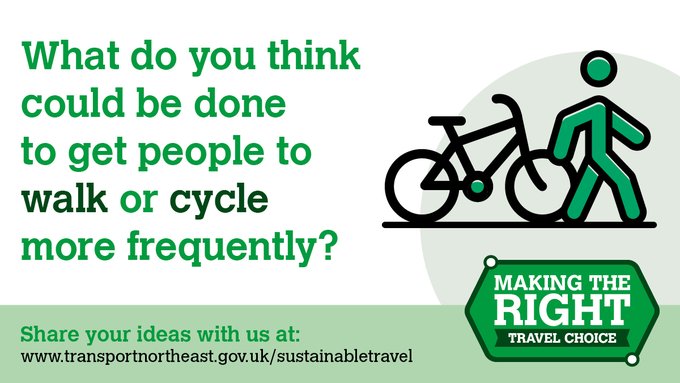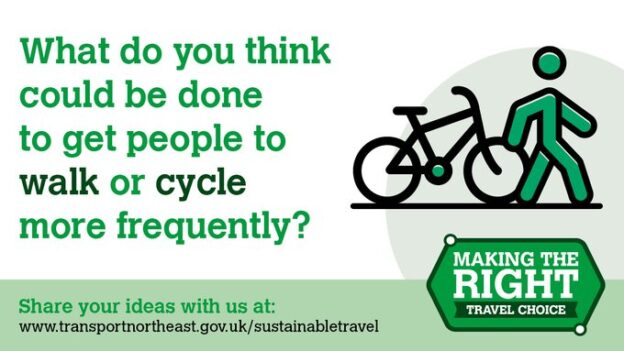
Transport for the North East are working on a new strategy Making the Right Travel Choice which aims to make it easier for local people make more sustainable journeys such as journeys on foot, by bike or using public transport.
The objective of the strategy is for people “to switch one journey a week to public transport, walking or cycling and for people who don’t have access to a car to continue to travel sustainably” potentially removing 200 million unnecessary car trips from our region’s roads.
You only have until Wednesday 14 September 2022 if you wish to respond.
The public survey is here: https://t.co/x2YCZOOb1A
You can read the draft strategy here: https://www.transportnortheast.gov.uk/making-the-right-travel-choice/
This is the SPACE for Gosforth response.
Dear Transport for the North East,
RE: Making the Right Travel Choice Consultation 2022
Target: The strategy sets a target to encourage car users to switch one journey a week to public transport, walking or cycling and for people who don’t have access to a car to continue to travel sustainably.
SPACE for Gosforth supports well-evidenced interventions to enable more people to walk or cycle more often. More walking / cycling enables people to access local services and job opportunities, save money and improve their health. As well as benefits to the individual, these have wider economic benefits and reduce the burden on the NHS.
We also support effective measures to reduce overall traffic levels, to reduce air and noise pollution, road danger and cut carbon emissions.
Our concern with the interventions listed in the “How do we get there?” section of the strategy is that substantially they do not address the main barriers to walking and cycling and/or have limited (or no) evidence to suggest they will be effective.
A number of the interventions, for example Go Smarter, appear to be a continuation of previous initiatives.
What are the barriers to walking and cycling?
There is plenty of good evidence on what prevents people walking and cycling.
The Government’s National Travel Attitudes Study: Wave 5 concluded that “Off-road and segregated cycle paths (55%), safer roads (53%) and well-maintained road surfaces for cycling (49%) were chosen most often when Wave 5 respondents (who didn’t state that cycling is impossible for them due to their disability) were asked about things that would encourage them to cycle more”.
In addition, nearly two-thirds (64%) of the sample supported the “creation of dedicated cycle lanes in their local area, even if this means less road space for cars.”
For walking, the top things that would encourage people to walk more were: well-maintained pavements, safer roads and more safe crossing points.
A recent study published in Transport Reviews came to similar conclusions for cycling, that motorist aggression, lack of high-quality bike lanes and perceived risk of injury were the main barriers.
NEW systematic review and meta-analysis out today in @TransptReviews – led by @Laurenk_pearson
— Ben Beck (@DrBenBeck) August 23, 2022
Most highly reported barriers of riding a #bike for #transport relate to having to ride a bike on the road and associated #safety concerns#openaccess link: https://t.co/rlXrlrcqLV pic.twitter.com/4sg8l4kHI7
Review: https://www.tandfonline.com/eprint/P2ZSPE7BH2KZ9AEGUEV9/full
The related Twitter thread is also worth a read.
https://twitter.com/DrBenBeck/status/1561867888599764993
A recent Guardian article gave some further case studies of why people who cycled during the Covid pandemic have not continued to cycle.
https://www.theguardian.com/commentisfree/2022/sep/03/cycling-dangerous-children-pandemic-closed-lanes-tacks-road
Notably none of these studies, nor Transport for the North East’s (TNE’s) own examples, mentions the need for messaging or incentives, which are the main actions proposed in TNE’s strategy document.
Effective Interventions
To address the main barriers, TNE should prioritise interventions to make roads safer including:
- Low traffic neighbourhoods by default
- Protected cycle lanes on main roads
- Lower speed limits
- Safer crossings
These will also support TNE’s ambition to achieve no deaths or serious injuries by 2025, which we believe is currently at risk due to lack of a plan or strategy to achieve it. We wrote about this in our blog No more road deaths, no more serious injuries.
Secure cycle parking at events and local destinations would also help.
To gain benefits associated with reduced traffic levels, TNE should focus on well-evidenced interventions that reduce total traffic levels, for example:
- Traffic restrictions
- Clear air zones
- Re-allocating road space to walking, cycling or public transport
- Increased parking charges / workplace parking levies
The tweet below illustrates the impact of good quality infrastructure. There may have been messaging and / or incentives for the children in the Netherlands to cycle to school but the main things that enabled this were safe routes and somewhere to securely store cycles at school.
https://twitter.com/grescoe/status/1564249783325364224
Some further examples are given in this paper, though it should be noted that in some cases the evidence given only confirms mode shift and not confirmation that total traffic levels reduced.
https://theconversation.com/12-best-ways-to-get-cars-out-of-cities-ranked-by-new-research-180642
Where people do switch from driving to public transport, walking or cycling that may reduce traffic temporarily, but traffic levels will quickly rebound due to induced demand. This is why mode-shift by itself is not sufficient to reduce total miles driven.
Messaging and Incentives
Clearly there is a place for messaging and incentives. Having these as the main strategic priorities though is unjustified and dangerous, as it diverts money from and reduces the likelihood of effective actions being taken.
Alignment with infrastructure changes feels likely to gain the greatest benefit, for example as in Newcastle’s school streets programme which all NE authorities should be replicating.
Other simple improvements in messaging can also be achieved at low cost including:
- Ensuring council transport comms explain the impact for people walking and cycling when a road is closed, not just for driving. For example, recent communications about the Pilgrim Street road closure did not mention walking or cycling. https://newcastle.gov.uk/citylife-news/transport/city-centre-traffic-changes-around-pilgrim-quarter-development
- Ensuring events and local destinations include how to arrive on foot, by bike, or by public transport, as well as by car, and include where to park a bicycle or cargo-bike. For example, The Chronicle wrote an article about car parking at the Great North Run but nothing on cycle parking. Newcastle City Council also produced an article about parking but nothing about cycle parking https://newcastle.gov.uk/our-city/visit/great-north-run
- Focusing on specific events, especially events where people attend regularly. For example, what safe routes could fans use to cycle to St James Park to see a match, and where can they lock up their bicycles securely close to the ground.
Conclusion
Thank you again for the opportunity to comment on the Transport for the North East draft Making the Right Travel Choice Strategy.
Urgent action is required to meet local and national net zero targets, to meet air pollution limits and to achieve Transport for the North East’s own objective of no one killed or seriously injured on the region’s roads by 2025.
We hope Transport for the North East will therefore take the opportunity to reconsider and to refocus its resources on actions that have the best possible chance of achieving these objectives as quickly as possible.
Yours faithfully,
SPACE for Gosforth.
www.spaceforgosforth.com

